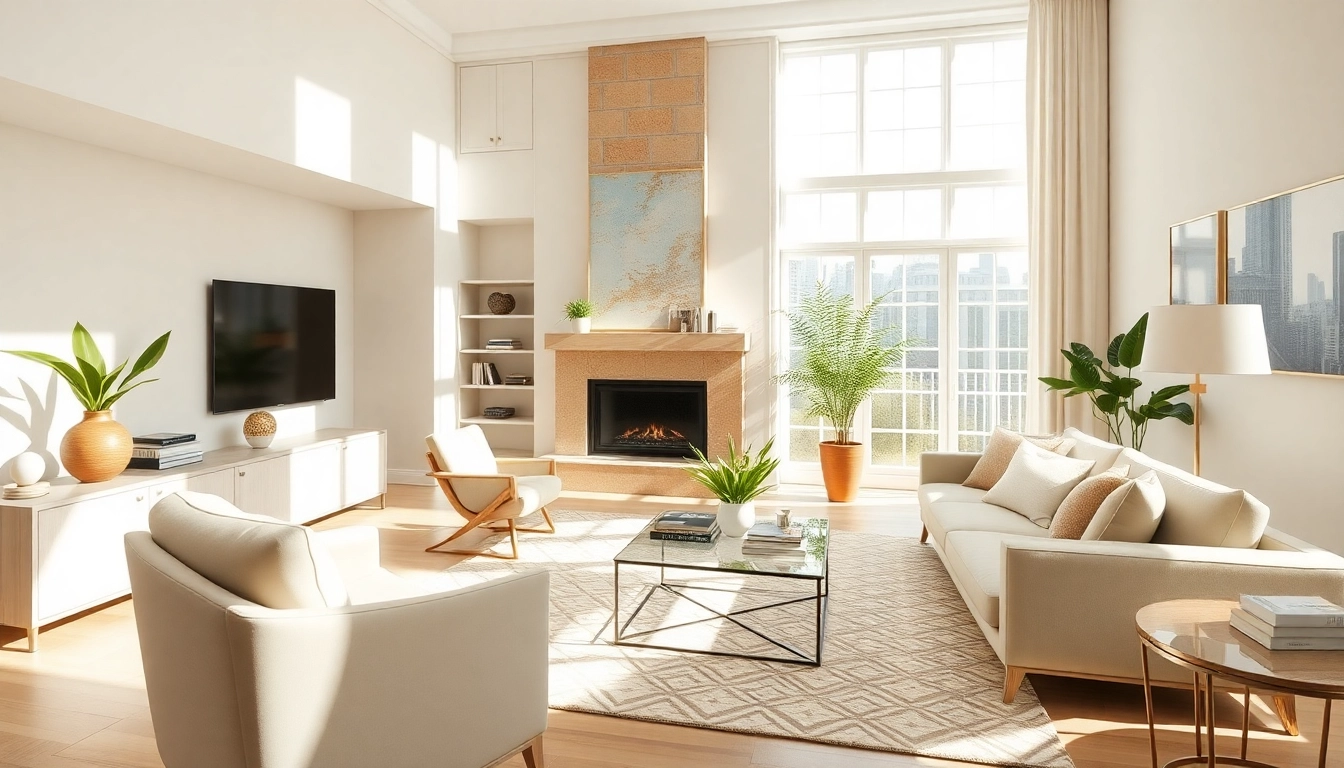
Understanding Your Entire Interior Design Needs
Transforming your living space is a daunting yet rewarding task, allowing you to create an environment that reflects your personality and lifestyle. Whether you want to redesign your home entirely or just refresh its look, understanding your entire interior design needs is crucial. This comprehensive guide will cover all aspects, from defining your style and assessing the space to budgeting for your project.
Defining Your Style and Vision
Your interior design journey begins with determining your style and vision. Are you drawn to the clean lines of modern design or the warmth of rustic chic? Here are key approaches to help you outline your vision:
- Explore Different Styles: Research various design aesthetics, such as minimalism, bohemian, Scandinavian, and industrial. Create a mood board using platforms like Pinterest to gather images that resonate with you.
- Identify Key Features: Focus on elements that appeal to you—such as specific furniture styles, color palettes, and textures. Consider how these pieces flow together to create a cohesive look.
- Visualize Your Space: Envision how each room will function and feel. Consider not only the aesthetics but also the comfort and functionality of the spaces in your home.
Assessing Space and Layout
After you’ve defined your style, it’s vital to assess your current space. Take measurements and note any architectural features like windows, doors, and built-in shelving that may influence your design decisions:
- Consider Floor Plans: Use software or simple graph paper to sketch out different layouts that optimize the flow and functionality of your spaces.
- Evaluate Natural Light: Pay attention to how light enters your home and plan the arrangement of furniture and decor to enhance brightness.
- Think About Traffic Patterns: Design with movement in mind. Ensure that pathways are clear within rooms and between spaces for a comfortable experience.
Setting a Budget for Your Transformation
Every successful project begins with an effective budget. An estimate allows you to prioritize features and manage costs effectively:
- Estimate Costs: Create a list of items you need to purchase, from furniture to paint. Research average prices in your area to estimate total costs accurately.
- Include Contingencies: Set aside an additional 10-20% of your budget to cover unexpected expenses, such as repairs or additional decor needs.
- Stick to Your Financial Plan: Regularly track your spending against your budget to avoid overspending and make necessary adjustments.
Choosing the Right Color Scheme for Your Entire Interior
The color scheme sets the tone for your entire interior and can heavily influence mood and perception. Choosing wisely will ensure a cohesive, attractive look throughout your home.
Popular Color Trends for Whole Home Designs
Staying updated with current trends in color can inspire your choices. Some popular trends include:
- Neutrals with a Twist: Incorporating shades like taupe, greige, and soft whites can bring warmth while being versatile.
- Accent Colors: Utilize bold hues, like navy blue or emerald green, to create focal points, especially in accessories, furniture, and art.
- Natural and Earth Tones: Colors inspired by nature such as sage green, terracotta, and muted blue can bring a sense of calm and connection to the outdoors.
How Colors Affect Mood and Perception
Understanding color psychology can enhance your design:
- Warm Colors: Reds, oranges, and yellows can create energy and excitement but can also be overwhelming in large amounts.
- Cool Colors: Blues, greens, and purples promote calmness and tranquility, making them perfect for bedrooms and relaxation spaces.
- Neutral Colors: These can serve as a versatile backdrop, making spaces feel larger while allowing decor to shine.
Creating Cohesion Across Different Rooms
Your entire home should feel like a cohesive unit. To achieve this:
- Flow of Colors: Use a consistent color palette and accent colors throughout your home to create a unified look.
- Transitional Spaces: Pay special attention to hallways and transitional areas to ensure they bridge different spaces effectively.
- Accents and Accessories: Cohesively use decor items like cushions, curtains, and artwork to connect varying room styles.
Furniture and Decoration Choices for the Entire Interior
Choosing the right furnishings and decorations will enhance not only your style but also the functionality of your living space.
Selecting Functional yet Aesthetic Furniture
Furniture should be as practical as it is beautiful. Consider the following:
- Scale and Proportion: Select furniture that fits the size of your rooms; oversized pieces can overwhelm smaller spaces.
- Quality Over Quantity: Invest in fewer, higher-quality pieces that will last and can adapt to different styles over time.
- Multi-Functional Furniture: Look for pieces that serve more than one purpose, like ottomans with storage or expandable tables.
Integrating Decor to Complement Your Style
Decoration is where your personality shines, and should reflect your tastes and interests:
- Art: Choose art pieces that resonate with you, and use them to set the emotional tone of each room.
- Accessories: Incorporate cushions, throws, and rugs that add texture, color, and comfort to your design.
- Plants: Adding greenery can brighten spaces and improve air quality while providing a connection to nature.
Maximizing Space with Smart Design Solutions
When dealing with limited space, design smartly to optimize what you have:
- Open Shelving: Use open shelves to keep items accessible and visually appealing, while also avoiding overcrowding.
- Mirrors: Place mirrors strategically to create the illusion of space and reflect light throughout your home.
- Vertical Storage: Utilize vertical space with shelves and hooks to keep the floor clear, which can make rooms feel larger.
Best Practices for Painting Your Entire Interior
Painting your home is a relatively inexpensive way to transform its look. However, maximizing the impact of this effort involves understanding the process:
Preparation Steps for a Successful Paint Job
Preparation is key to a flawless paint job; follow these steps:
- Clean and Repair Walls: Fix any holes or imperfections and wash the walls to ensure the paint adheres properly.
- Use Quality Materials: Invest in high-quality paintbrushes and rollers, as well as painter’s tape to achieve crisp lines.
- Test Paint Colors: Always test paint samples on your walls to see how they look in different lighting throughout the day.
Selecting the Right Paint Finishes
Choosing the right finish can influence both appearance and functionality:
- Matte Finish: Great for ceilings and low-traffic areas, it hides imperfections but can be harder to clean.
- Satin Finish: Offers a soft sheen and easy wipeability, making it ideal for living areas and hallways.
- Glossy Finish: Highly reflective and durable, perfect for cabinets and trim, providing both style and practicality.
DIY vs. Hiring Professionals: What to Consider
Deciding between DIY painting or hiring professionals depends on factors like your skills, time, and budget:
- Time Commitment: Consider whether you can dedicate the time required for a thorough DIY job, including prep and cleanup.
- Skill Level: If you’re inexperienced, professional painters can ensure high-quality results and save time.
- Budget Constraints: Weigh the cost of hiring experts against DIY material costs to determine the best route for your project.
Maintaining the Elegance of Your Entire Interior
Once your interior is transformed, maintaining its elegance is crucial to enjoying the space for years to come. Here are strategies for keeping your home looking its best:
Tips for Regular Upkeep and Cleaning
Routine care helps to preserve your home’s beauty:
- Establish Cleaning Routines: Implement daily and weekly habits that focus on organized cleaning tasks to keep dirt at bay.
- Use Soft and Gentle Cleaners: Choose products that are appropriate for your surfaces to avoid damage, especially on painted walls and furnishings.
- Maintain Textiles: Regularly vacuum carpets, dust furniture, and wash/change linens to keep everything fresh.
Updating Your Decor Seasonally
Keeping your space dynamic and engaging involves updating decor based on seasonal changes:
- Seasonal Accents: Change throw pillows, rugs, and artwork with the seasons to introduce new colors and patterns.
- Light and Airy vs. Cozy and Warm: Alter lighting and fabric choices from lighter tones in summer to heavier textiles in winter for a cozy feel.
- Plant Changes: Rotate plants according to season, and consider seasonal flowers or arrangements for visual interest.
Common Mistakes to Avoid for Lasting Beauty
To maintain your home’s elegance, avoid these common pitfalls:
- Overcrowding Spaces: Keep your decor curated and intentional to avoid a cluttered appearance.
- Ignoring Lighting: Natural and artificial lighting play a significant role in the overall aesthetics; ensure every room is adequately lit.
- Neglecting Repair Work: Address minor repairs promptly to prevent them from becoming larger issues and preserving your home’s appeal.








